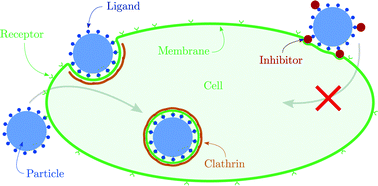The morphological role of ligand inhibitors in blocking receptor- and clathrin-mediated endocytosis†
Abstract
Cells often internalize particles through endocytic pathways that involve the binding between cell receptors and particle ligands, which drives the cell membrane to wrap the particle into a delivery vesicle. Previous findings showed that receptor-mediated endocytosis is impossible for spherical particles smaller than a minimum size because of the energy barrier created by membrane bending. In this study, we investigate the morphological role of ligand inhibitors in blocking endocytosis, inspired by antibodies that inhibit virus ligands to prevent infection. While ligand inhibitors have the obvious effect of reducing the driving force due to adhesion, they also have a nontrivial (morphological) impact on the entropic and elastic energy of the system. We determine the necessary conditions for endocytosis by considering the additional energy barrier due to the membrane bending to wrap the inhibiting protrusions. We find that inhibitors increase the minimum radius previously reported, depending on their density and size. In addition, we extend this result to the case of clathrin-mediated endocytosis, which is the most common pathway for virus entry. The assembly of a clathrin coat with a spontaneous curvature increases the energy barrier and sets a maximum particle size (in agreement with experimental observations on spherical particles). Our investigation suggests that morphological considerations can inform the optimal design of neutralizing viral antibodies and new strategies for targeted nanomedicine.



 Please wait while we load your content...
Please wait while we load your content...